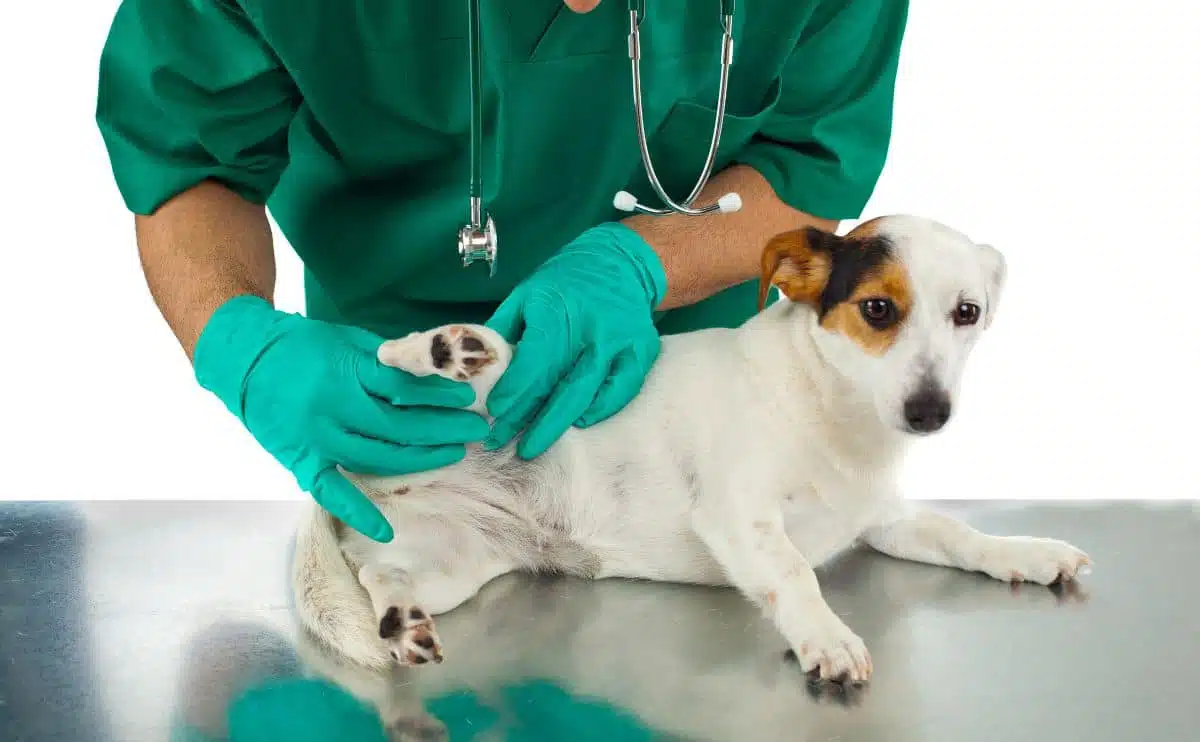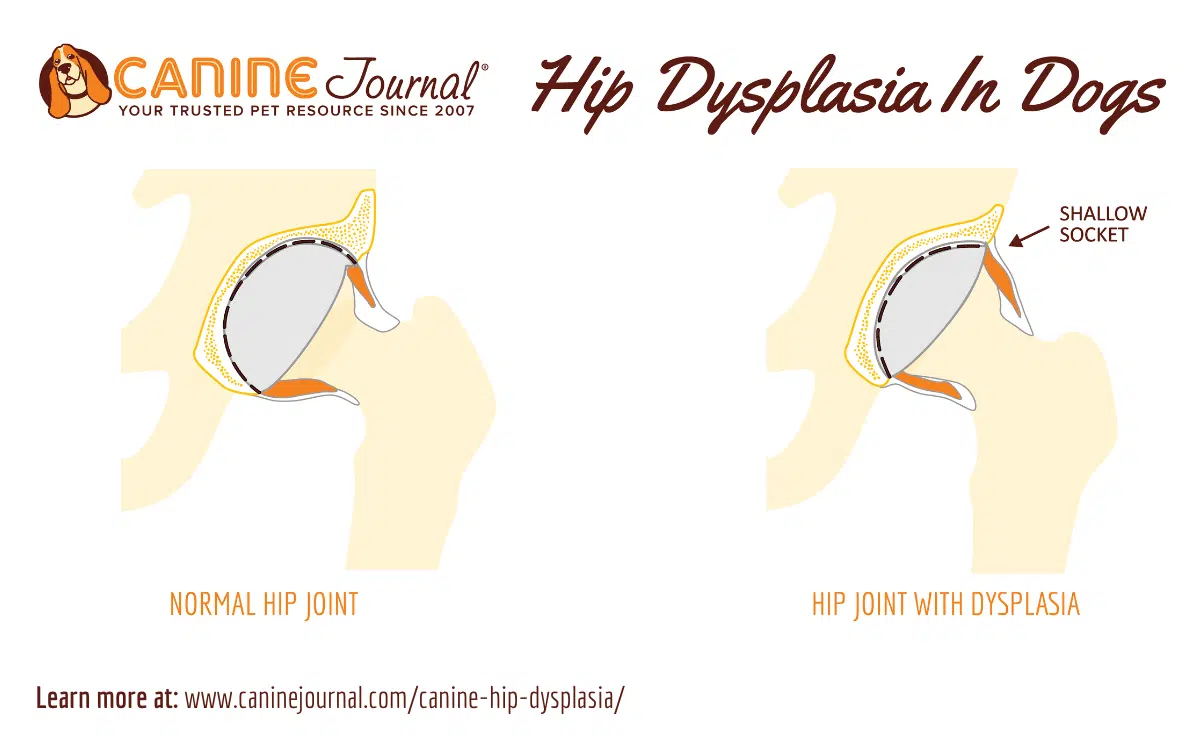Does Pet Insurance Cover Hip Dysplasia?
To keep the lights on, we receive affiliate commissions via some of our links. Our review process.

Hip dysplasia is one of the most commonly diagnosed conditions in dogs, especially large breeds. But is this condition eligible for pet insurance coverage, or do providers leave pets and their parents to fend for themselves in their time of need? Let’s dive into the details surrounding hip dysplasia and see if you can count on pet insurance to cover a hip dysplasia diagnosis.
What Is Hip Dysplasia?

Canine hip dysplasia is a chronic (persistent or long-lasting) condition in which the head of the femur bone doesn’t fit correctly into the hip socket (acetabulum). The acetabulum is shallow, and instead of resting in the hip socket, the head of the femur slides around against the socket. The misalignment or subluxation of the joint causes extremely painful bone spurs, which makes walking difficult for the dog. And unfortunately, dogs suffering from hip dysplasia are more susceptible to arthritis in that same area.
Hip dysplasia is one of the most commonly occurring orthopedic conditions in dogs, especially larger breeds. It is often hereditary and gets worse with age. Responsible dog breeders should refrain from breeding dogs with orthopedic issues to reduce the risk of this painful condition in future generations.
What Does Treatment For Hip Dysplasia Cost? Is Surgery Needed?
Surgery is sometimes recommended to improve your dog’s quality of life. Surgery can cost anywhere from $1,700 to $4,500+. Depending on the severity and condition of your dog’s hip dysplasia, an orthopedic surgeon may opt for one of the surgery techniques below.
- Juvenile Pubic Symphysiodesis – This less invasive technique is performed on dogs younger than five months old. The surgeon fuses the two pelvic bones to allow the other pelvic bones to develop properly. This helps improve hip mobility by changing the hip angles.
- Triple Pelvic Osteotomy (TPO) – The surgeon makes bone cuts in the pelvis to correct the joint anatomy. TPO surgery is commonly recommended for younger dogs with subluxation because it restores the full function of the hip joints. The surgery is expensive and painful, which is why it’s only for dogs 10 months or younger because they recover more quickly. This isn’t effective for pups with existing damage in the hip socket.
- Femoral Head Ostectomy (FHO) and Neck Excision – The femoral head is removed from the hip joint, and, over time, scar tissue will create a “false joint” to hold the femur in place. This surgery is more affordable than a total hip replacement, but it isn’t typically a suitable option for heavier or younger dogs. The surgery relieves most of the dog’s pain, but the range of motion and stability isn’t entirely corrected.
- Total Hip Replacement (THP) – THPs are the most invasive, but they restore full function to the hip joint. The cost is high, and surgeons only perform THPs on fully grown dogs showing signs of end-stage hip dysplasia or severe hip dysplasia. The hip joint is removed and replaced with an artificial joint during the surgery. After your dog’s THP, they should live a pain-free life (related to their hips) and have a near-normal range of motion.
Does Pet Insurance Cover Hip Dysplasia?
Yes, pet insurance covers hip dysplasia as long as no signs or symptoms appear until after policy enrollment and waiting periods have passed. Hip dysplasia symptoms can start as early as 4 months after birth but are more commonly evident in dogs one to two years old.
What Are Hip Dysplasia Waiting Periods For Pet Insurance?
The average pet insurance waiting period for illnesses is 14 days (some are up to 30 days). However, some pet insurance companies have additional waiting periods for hip dysplasia (up to 12 months for some providers). The table below shows top pet insurance companies and how long their waiting periods are for hip dysplasia.
You should enroll your dog in pet insurance as soon as possible to increase your chances of having pet insurance coverage for the possibility of hip dysplasia or other unexpected health conditions. Most pet insurance companies begin enrollment around six to eight weeks old.
A Vet’s Input On Hip Dysplasia
“Sadly, hip dysplasia is a common condition in dogs. It is estimated to affect around 15% of dogs in the US and Canada. The incidence is highest in large and giant breeds, and is even thought to be as high as 70% in some breeds.
One of the most common questions I get asked about hip dysplasia is how it will affect the quality of life of the pup. Well, hip dysplasia needs lifelong treatment and it is a painful condition. All dogs with hip dysplasia will develop arthritis at some point. Some of the symptoms we commonly see are limping, stiffness, difficulty getting up or lying down, a wobbly back end (ataxia) and/or ‘bunny hopping’ (where the pup runs with both back legs moving together at the same time). However, in some mild cases, we don’t see any symptoms until later in life, when the arthritis develops.
The good news is that most cases of hip dysplasia can be well managed. Most dogs with hip dysplasia can lead a good quality and happy life, with an individually-tailored plan for pain relief, weight control, controlled exercise, and sometimes surgery. Physiotherapy and hydrotherapy are also great for these pups, to help build and maintain muscle, taking some pressure off the hips.”
– Dr. Sarah-Jane Molier, BSc, BVM&S, MRCVS
Note: Some pet insurance companies offer coverage for alternative and holistic treatments like hydrotherapy, massage, acupuncture, and more. So be sure to read your policy’s fine print if this is of interest to you.
How To Choose The Best Pet Insurance
Pet insurance covers many health conditions besides hip dysplasia. Fortunately, hip dysplasia coverage is fairly standard in pet insurance, but the waiting period will be the largest difference you’ll notice among providers. You should consider several other factors before enrolling your dog, including overall policy coverage, customer service and reputation, claim processing average, pricing, plan customizations, and more. We go into great detail on these categories and rank the best pet insurance companies to help you make the most informed decision.
Tagged With: Reviewed By Insurance Agent




